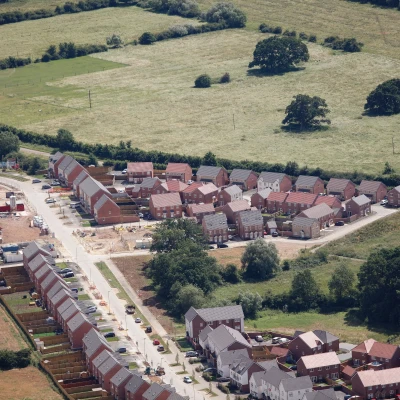Shared ownership potential and the need to unleash it

By Adrian Plant, Director of SOWN, (part of Leaders Romans Group)
While housebuilders are increasingly looking for novel and engaging means of marketing to achieve the necessary supply:demand balance in a challenging market, providers of shared ownership have the opposite problem. In the world of shared ownership, demand consistency exceeds supply, and the gap is continuing to grow.
This is not so much good news for our sector as a very real concern on a social level. And the reasons are multifarious.
The impact of the housebuilding slowdown
In the last year housebuilding has slowed down considerably: more than half a million new developments have been put on hold during the past five years and official data shows that only 19% of planning applications are processed within the recommended 13 weeks, compared with 57% a decade ago. Because around half of new affordable housing (which includes shared ownership) is delivered through conditions imposed on development through ‘planning gain’, the reduction in housebuilding (through lack of demand) results directly in a reduction in shared ownership properties (the demand for which increases in a challenging market).
And as the already acute need for affordable housing increases, the planning system alone cannot keep up with the volume of new homes required. This may be exacerbated if the proposed Infrastructure Levy is introduced, because it would result in planning gain revenue becoming available for local authorities to spend on the many wide-ranging financial demands that they face in addition to housing.
Furthermore, the supply of shared ownership housing was further threatened when it was announced in early January that housing associations in England are due to have planned spending on new affordable homes cut in 2024. Following research by Centrus it is anticipated that funding for 2024 will be reduced by 9 per cent (£1.5bn) compared with the previous year’s forecast.
Growing demand
Constraints in the economy generally have substantially increased demand for shared ownership and, against the odds, the sector has made considerable progress in meeting this demand. 19,386 new shared ownership properties were delivered in 2021-22 according to the English Housing Survey. This is the highest number since records began in 2014-15, a 14% increase on the previous year.
Shortly after what is now commonly known as the ‘disastrous mini budget’ of 2022, the Commons Public Accounts Committee commented that targets for building affordable homes were ‘depressingly unattainable’. An additional 340,000 homes were needed to keep up with growing demand, it said, with a large proportion of these properties being affordable.
Inevitably, given the economic downturn, demand for affordable housing, and shared ownership specifically, is extending to a wider demographic.
Today first-time buyers in the UK today are paying almost a third more to get on the property ladder than they were five years ago and in the last decade the number of private renters moving into home ownership fell by 23%.
Traditionally shared ownership is most popular among those aged between 25-35 (32-37 in London) but, as salaries fail to increase in line with inflation, the upper age is increasing. In fact we are seeing a significant increase in the 65s plus demographic – those can’t afford to stay in their homes due to reduced incomes and higher mortgage rates; those who pass equity to younger family members, and those who are downsizing to reduce bills.
In the five years 2018 to 2023 the average house price rose by as much as 40% in some regions, while the average income rose by just 11.6% in the same period.
Although shared ownership remains limited to those with a maximum household income of £80K (£90K in London), many people are finding that due to the impact of interest rates rises on mortgages, car and credit card loans together with the cost of food and utility bills, they can no longer afford to buy outright, and shared ownership is a good alternative.
In many parts of the country, specifically the Thames Valley, where the head office of SOWN and its parent group Leaders Romans Group are based, the issue is reaching crisis point as the affordability of homes, both to buy and to rent, is inaccessible to many. In addition to forcing people to relocate away from families and friends, the resultant shortage of key workers in the area affects us all.
No more Help to Buy
Perhaps the greatest impact on the demand for shared ownership housing was the cessation of the Government’s Help to Buy scheme last year.
Although various initiatives aimed at first time buyers remain, the absence of Help to Buy is very strongly felt. The scheme, which enabled buyers to buy with a 5% deposit using an equity loan worth 20% of the price of a new build home (40% in London), aided the purchase of almost 390,000 new build homes.
During this time, £24.7bn of government loans were advanced to support home buyers, allowing sales of houses worth £109.2bn to go ahead. Just under 85% of homes sold under the scheme were sold to first time buyers.
It was inevitable therefore that in July 2023 the UK’s largest housebuilder Barratt said the number of first-time buyers acquiring its homes had fallen by 49% in the past year as Help to Buy was wound down, and predicted a drop of 23% in build volume over period July 2023-24.
Alternative Help to Buy?
In the wake of Help to Buy, the Government has put in place a range of means through which first time buyers (and in some cases others) can purchase a property with financial support. These include First Homes, Deposit Unlock, Discount Market Sale, Discount Full Ownership, Intermediate Rent, Lifetime ISAs, London Living Rent and Rent to Buy.
Non-government supported initiatives are largely limited to privately available financial products, including first time buyer mortgages at 95% or even 100%, guarantor mortgages, joint mortgages and of course the nice-to-have (but not readily available) Bank of Mum and Dad. But there are clear downsides to each.
Potential for the expansion of shared ownership
And so it’s no surprise that the most popular initiative by far is shared ownership, which allows eligible purchasers to buy a share of a new build or resale home, paying a mortgage on the part being purchased and a below-market-value rent on the remainder.
The supply of shared ownership homes has increased in recent years. Around 4,080 units were completed in 2015/16, rising to a peak of around 18,220 in 2019/20 and falling slightly to 17,100 in 2020/21. In total, approximately 76,500 new shared ownership homes were delivered between 2015 and 2021.
But, as I explained earlier, shared ownership is not as a widespread tenure as is required. There are approximately 202,000 households living in shared ownership homes in England, which represents less than 1% of all households. Demand varies across the regions, with demand highest in areas where affordability is most stretched – largely in the south of England. Our schemes in London include Clarendon on Hornsey High Street in the heart of north London and Ferry Island North Heart of Hale, located just moments from Tottenham Hale station. Both have proved extremely popular, attracting a wide demographic.
Government support needed
So what needs to change to replicate this success elsewhere?
The government’s Affordable Homes Programme is an important foundation to build from but so far fails to comprehensibly address increased demand.
My view is that the government needs to get behind shared ownership in the same way it did Help to Buy. Help to Buy benefited from a dedicated, widely recognised brand with an effective information campaign and website which pointed would-be purchasers in the direction of suitable products. There many myths around shared ownership which need to be addressed (for example that shared ownership is that it’s only available to people with low incomes or those on social housing lists; that you can never fully own a property through shared ownership; that shared ownership properties are of inferior quality compared to properties sold on the open market; that It’s difficult to sell a shared ownership property, or that shared ownership is only available for flats… the list goes on) – but doing so comes at a cost.
There is also a need to reconsider how funding for shared ownership is derived, especially in the context of a potential recession and changes to the planning gain system.
Helping first time buyers and others to get on to the property ladder is vital not only for the individuals involved but for the country’s social and financial prospects. We have a great product and great demand for it – but more needs to be done to fully realise this potential.

Contact Us
Got a question, general enquiry or something else?
You may also like
Since we started in 1987 we have grown to one of the UK’s largest property groups, we can save you time and money by offering a range of services and expertise under one roof.




